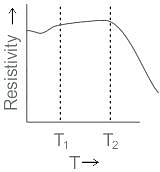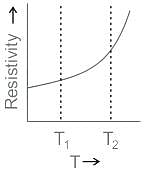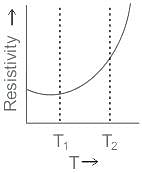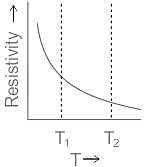UGC NET Exam > UGC NET Questions > The temperature variation of the resistivity ...
Start Learning for Free
The temperature variation of the resistivity of 4 materials are shown in the following graphs. Which one is more sensitive make a temperature sensor?
- a)

- b)

- c)

- d)

Correct answer is option 'D'. Can you explain this answer?
| FREE This question is part of | Download PDF Attempt this Test |
Most Upvoted Answer
The temperature variation of the resistivity of 4 materials are shown ...
When there is minima or maxima in the graph of resistivity vs temperature,
Then it indicates that there will be two different temperatures for which the material will show the same resistivity.
That kind of resistivity variating materials are not suitable candidates for sensors as they can be misleading.
Hence the only resistivity profile that is suitable for the temperature sensor is given by the one that shows some monotonic behavior.
Then it indicates that there will be two different temperatures for which the material will show the same resistivity.
That kind of resistivity variating materials are not suitable candidates for sensors as they can be misleading.
Hence the only resistivity profile that is suitable for the temperature sensor is given by the one that shows some monotonic behavior.
Attention UGC NET Students!
To make sure you are not studying endlessly, EduRev has designed UGC NET study material, with Structured Courses, Videos, & Test Series. Plus get personalized analysis, doubt solving and improvement plans to achieve a great score in UGC NET.

|
Explore Courses for UGC NET exam
|

|
The temperature variation of the resistivity of 4 materials are shown in the following graphs. Which one is more sensitive make a temperature sensor?a)b)c)d)Correct answer is option 'D'. Can you explain this answer?
Question Description
The temperature variation of the resistivity of 4 materials are shown in the following graphs. Which one is more sensitive make a temperature sensor?a)b)c)d)Correct answer is option 'D'. Can you explain this answer? for UGC NET 2024 is part of UGC NET preparation. The Question and answers have been prepared according to the UGC NET exam syllabus. Information about The temperature variation of the resistivity of 4 materials are shown in the following graphs. Which one is more sensitive make a temperature sensor?a)b)c)d)Correct answer is option 'D'. Can you explain this answer? covers all topics & solutions for UGC NET 2024 Exam. Find important definitions, questions, meanings, examples, exercises and tests below for The temperature variation of the resistivity of 4 materials are shown in the following graphs. Which one is more sensitive make a temperature sensor?a)b)c)d)Correct answer is option 'D'. Can you explain this answer?.
The temperature variation of the resistivity of 4 materials are shown in the following graphs. Which one is more sensitive make a temperature sensor?a)b)c)d)Correct answer is option 'D'. Can you explain this answer? for UGC NET 2024 is part of UGC NET preparation. The Question and answers have been prepared according to the UGC NET exam syllabus. Information about The temperature variation of the resistivity of 4 materials are shown in the following graphs. Which one is more sensitive make a temperature sensor?a)b)c)d)Correct answer is option 'D'. Can you explain this answer? covers all topics & solutions for UGC NET 2024 Exam. Find important definitions, questions, meanings, examples, exercises and tests below for The temperature variation of the resistivity of 4 materials are shown in the following graphs. Which one is more sensitive make a temperature sensor?a)b)c)d)Correct answer is option 'D'. Can you explain this answer?.
Solutions for The temperature variation of the resistivity of 4 materials are shown in the following graphs. Which one is more sensitive make a temperature sensor?a)b)c)d)Correct answer is option 'D'. Can you explain this answer? in English & in Hindi are available as part of our courses for UGC NET.
Download more important topics, notes, lectures and mock test series for UGC NET Exam by signing up for free.
Here you can find the meaning of The temperature variation of the resistivity of 4 materials are shown in the following graphs. Which one is more sensitive make a temperature sensor?a)b)c)d)Correct answer is option 'D'. Can you explain this answer? defined & explained in the simplest way possible. Besides giving the explanation of
The temperature variation of the resistivity of 4 materials are shown in the following graphs. Which one is more sensitive make a temperature sensor?a)b)c)d)Correct answer is option 'D'. Can you explain this answer?, a detailed solution for The temperature variation of the resistivity of 4 materials are shown in the following graphs. Which one is more sensitive make a temperature sensor?a)b)c)d)Correct answer is option 'D'. Can you explain this answer? has been provided alongside types of The temperature variation of the resistivity of 4 materials are shown in the following graphs. Which one is more sensitive make a temperature sensor?a)b)c)d)Correct answer is option 'D'. Can you explain this answer? theory, EduRev gives you an
ample number of questions to practice The temperature variation of the resistivity of 4 materials are shown in the following graphs. Which one is more sensitive make a temperature sensor?a)b)c)d)Correct answer is option 'D'. Can you explain this answer? tests, examples and also practice UGC NET tests.

|
Explore Courses for UGC NET exam
|

|
Suggested Free Tests
Signup for Free!
Signup to see your scores go up within 7 days! Learn & Practice with 1000+ FREE Notes, Videos & Tests.






















